This is it! This is what I set out to do since the beginning of this challenge - to check if my garage is out to kill me ;)
Over the last few months, I was able to get the air quality sensor connected to a WiFi enabled Arduino MKR WIFI 1010 board, and I was able to get it to successfully send data to my Raspberry Pi server. I then tested it on an extended test run in my office, comparing base-level air quality numbers to those with the window open, and with two different ionic air filters running. Interesting results to say the least! Check out my previous blog post for that.
And now we are ready for the big times: We are monitoring the air quality in my garage - my number one goal for this challenge!
Physically speaking, the garage is actually not far from my home office - it's on the other side of my floor! So in a way, the earlier office air tests also tested the 2nd part of my initial goals - whether or not the garage pollutants are making it into the house. And they thankfully didn't appear to affect my office.
For the Arduino sensor, the location of the garage keeps things simple too - the garage isn't much further from the WiFi router, so I can just plug the Arduino into an outlet in the garage and be fairly confident that it won't have any issues connecting to my network.
The garage has a countertop and a plug-in very handy, so that's where I a placed the sensor. It's right in front of one of the cars, but it's a fairly standard sized 2-car garage so I'm pretty sure the location of it doesn't matter a whole lot, unless it's right by a window or door. This countertop is at the back corner, furthest from the big doors and from the side door, so in terms of pollutants that's probably the best place for it. Countertop height is also nicely centered top to bottom, closer to the space where we breathe.
Before starting up the sensor in the garage, I put my weather station on the countertop to find out what the temperature and humidity are, so that I could adjust the sketch with those values hard-coded. I'm assuming the temperature and humidity won't swing too far off that mark, and I'm hoping any variations won't affect the overall results. Over my testing period that seems to have held true well enough.
On the first day, I started the sensor around 1pm with not much going on. One car had left a few hours earlier, but I've also been going in and out of the garage so the air quality in the garage was likely to be very close to the outside air quality.
Judging by the first numbers coming in, the air quality in the garage is actually a bit better than that in the house!
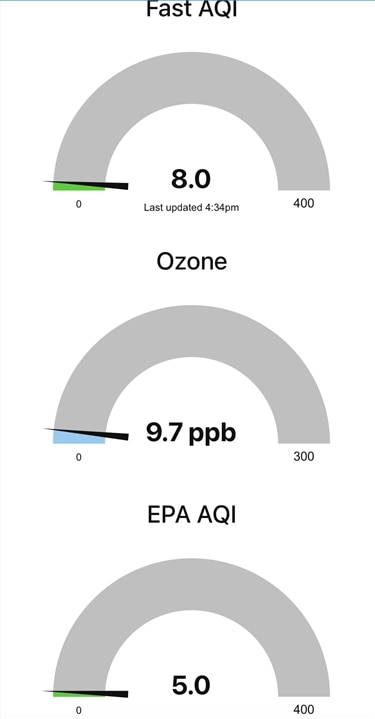
When the car (a Fiat 500) arrived home, the air quality numbers did not seem to be affected at all - you can notice that as part of the flat line on the left side of the upcoming chart. It was just before the step down, which seems to be a glitch with the sensor or the software that sometimes happens during the first few hours of data collection, but you can see that the chart before and after the glitchy part is fairly level around 10ppb.
The next day we took the Fiat out, and interestingly that DID affect air quality! You can see the bump up on the graph, which then slowly settles back down.
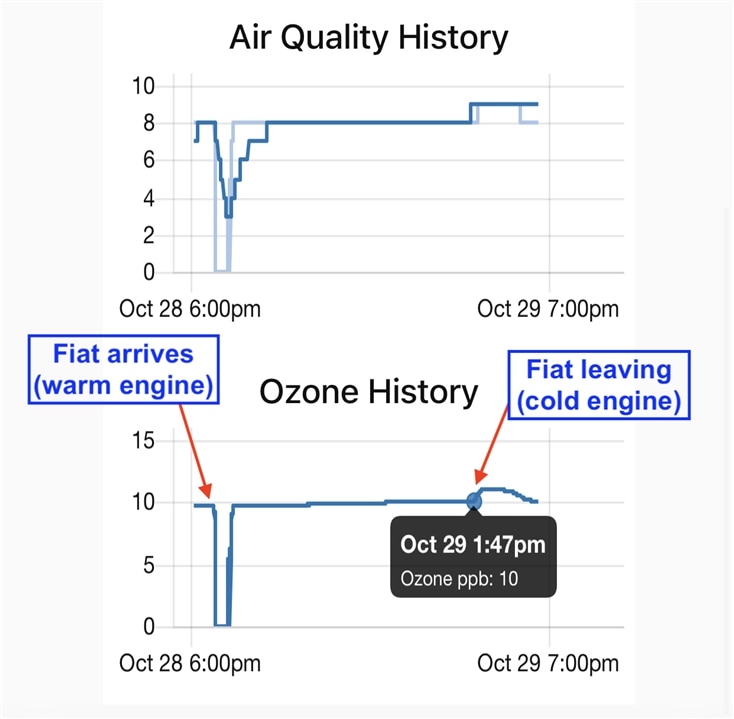
You can see the car exhaust peak more clearly once the graph moved past the zero-value glitches of the day before:

The start of the peak lines up exactly with the time we left, to the minute:
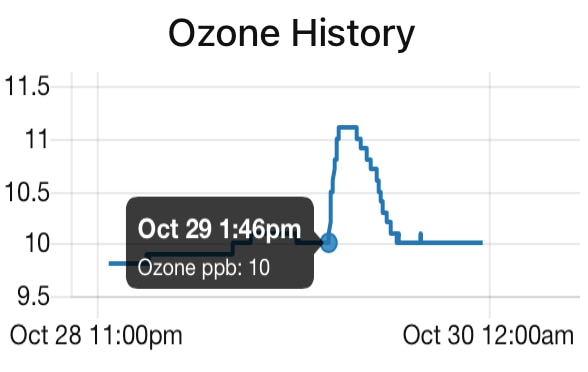
The graph doesn't show our arrival home, in neither a positive or negative way.
It seems that coming home with a warm engine doesn't affect air quality, but leaving definitely does - I'm guessing that's because the catalytic converter is doing its job when it's hot, but it hasn't heated up enough to work when the car first starts up. You can totally smell the difference too!
The other interesting bit of information from that is that the car leaving doesn't increase the air quality numbers too much - the result still leaves a better AQI than inside our house.
With the garage window closed, the pollutants do linger.
My neighbours tend to back their car into their garage, which puts the exhaust pointing into the far end of the garage, rather than out of the door... I bet that gets much nastier.
The Air In Here
More interesting data came in on Sunday, as we decided to clean out the crawlspace, which has an access hatch from the garage. It's a 6 foot tall space, and it's a conditioned space which is essentially a part of the house. During the time we were in there with the hatch to the garage open, the Ozone and AQI in the garage both increased!
That was most likely because the house levels were higher than the garage.
But why would that be? The basement doesn't have a lot of electronics - it does have a few networked backup drives, but that's all.
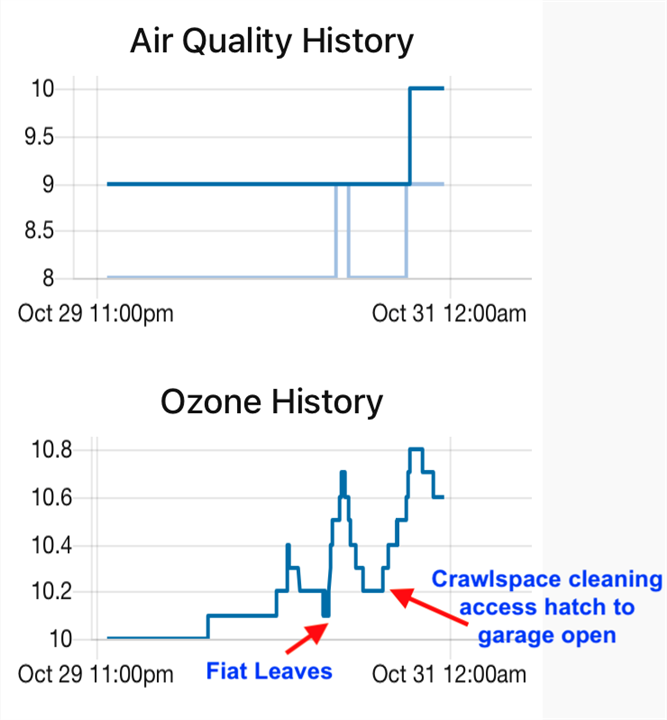
The Air Out There
What's even more interesting is when, the next day, I changed the tires of the car over to our winter tires, and I had both garage doors open the whole time. This was from roughtly 2pm to 4pm, and it's kinda scary to see the results - the Ozone and AQI both went up quite rapidly for the whole time the doors were open!
We didn't have cars coming or going, not even the neighbours, so I'm guessing the wind must be blowing pollution from either the city center or from the airport - I'm guessing the constant traffic in the city is the culprit.

Once I closed the doors the levels went down again almost immediately (see next chart). I'm actually not sure why that is - does the NO2 and Ozone break down somewhat quickly with time?
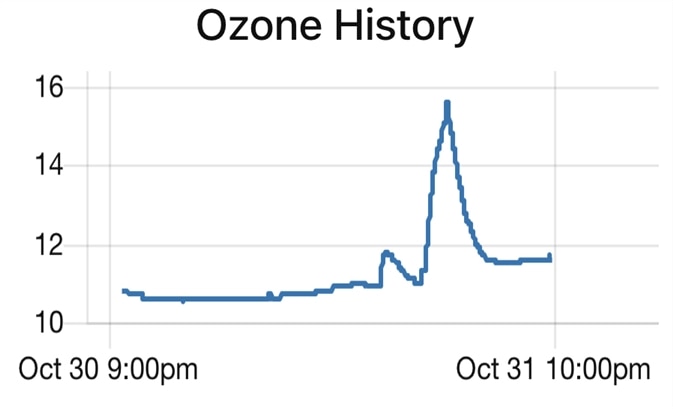
That might actually explain the higher levels of pollution in our crawlspace/basement - it has a continuous flow of make-up air for the gas hot water heater - which could also be a factor, but given the rapid rise from the outside air, I kind of suspect that the crawlspace was getting most of the pollution from the outside air via the make-up fresh air pipe that brings outside air into the house near the natural-gas hot water tank.
I knew it - this place used to be a small town, but it has become a... dare I say it?... CITY!
Maybe I need to move further North
So that tells us a little more about the effect of our own cars in the garage - the outside air from the city side has a much bigger effect than our own cars. I still wouldn't want to be idling the car while it's in the garage, of course.
I was going to do a second stage to the garage air quality testing, which was to keep the window open a crack to allow for continuous air ventilation. However, judging by the effect of having both garage doors open for a few hours, I don't think it matters whether that window is open or not, at least not in terms of AQI and ozone - the city pollution will be the deciding factor there, depending on the direction of the wind.
We generally do have to keep that window open a crack for most of the winter because of all the rain - the wet cars cause far too much humidity in there otherwise.
Here is a chart for a day we stayed home, and the ozone went up more than when we drove the car!
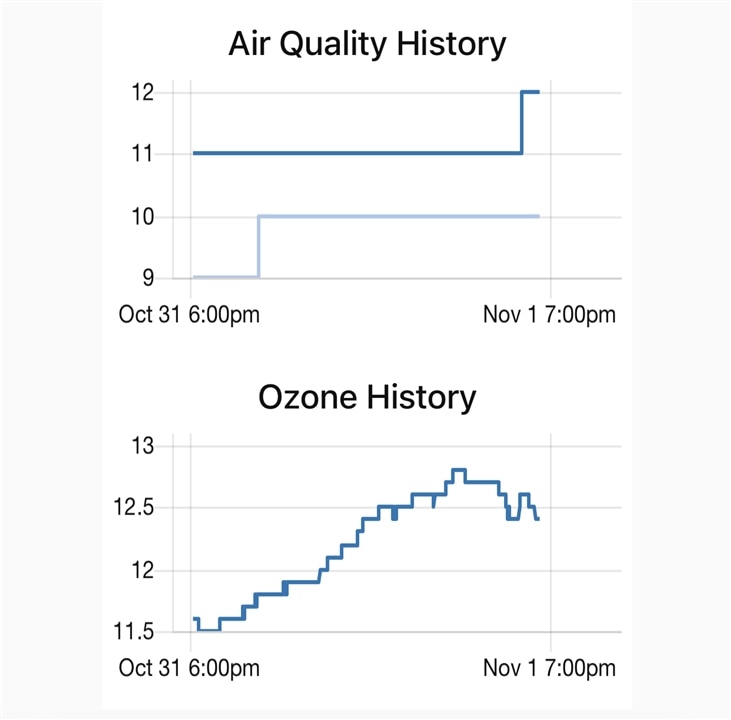
And one more chart from yesterday and today that add a few extra interesting bits of data:
The first two peaks at the far left of the graphs are:
(a) when the Fiat left and
(b) came back.
This time we didn't go far, so the engine may have still been somewhat cold.
The peaks at the far right add a new scenario:
(c) The first small bump is when Kia backed out of garage. My wife turned it around to put things from the garage into the back, so the exhaust was facing the open garage at that point.
(d) The bigger peak right after is when a truck was idling at the garage, and the Kia left - she likely had the garage doors open as she started the car again, with the exhaust facing into the garage this time. But, she also had the garage door open while packing things into the car.
(e) And finally, the little blip is when my wife returned in her Kia.
This last chart gives interesting data, but also adds a few more questions - did the air quality numbers go up due to the vehicles, or due to outside air pollution coming in, as we saw in the chart when I changed the tires.
I think for my next experiment I'll keep track of the outside air quality. If I'm on the ball enough for that I might even remember to track wind direction.


Top Comments